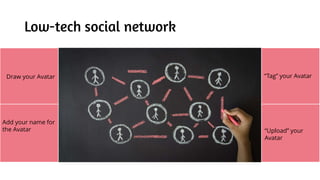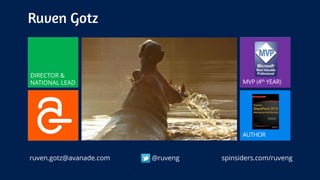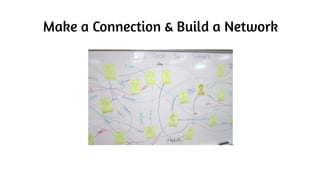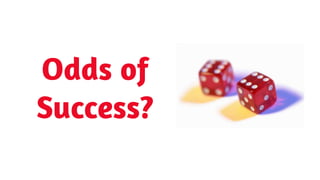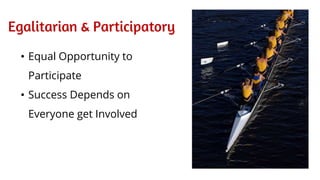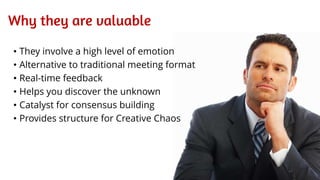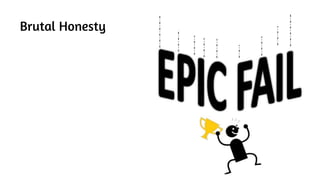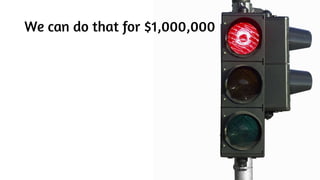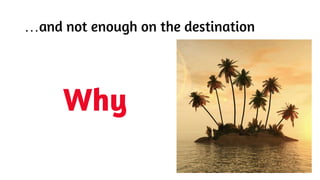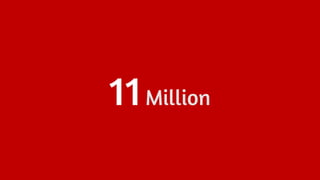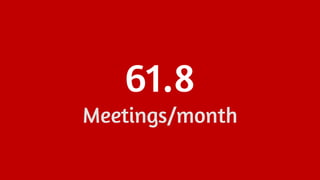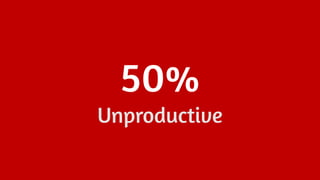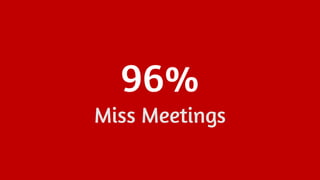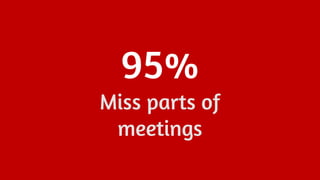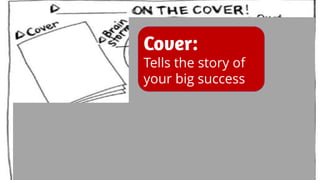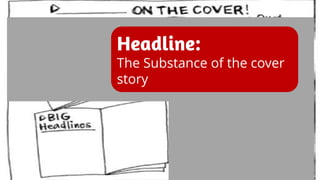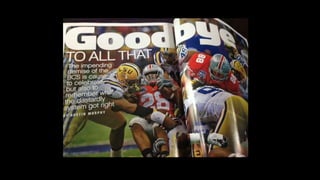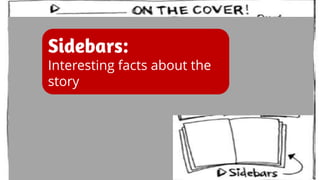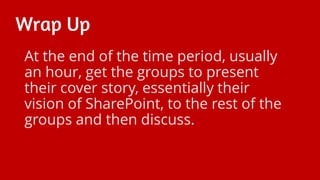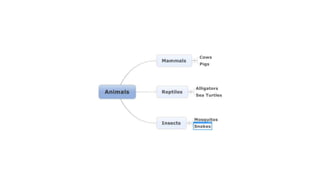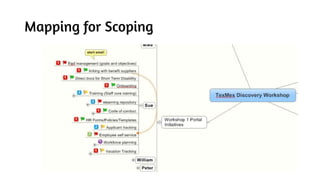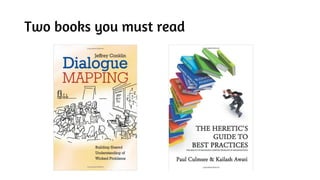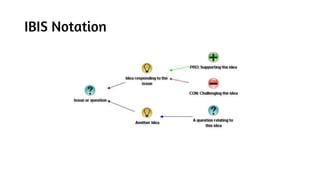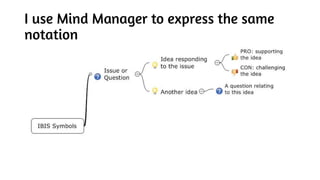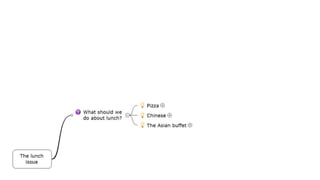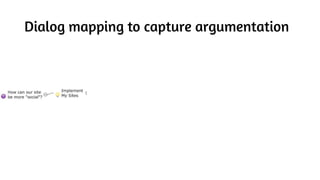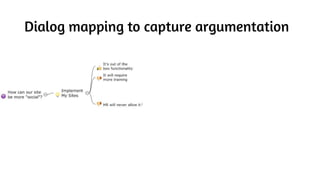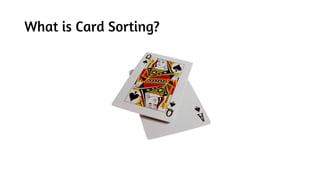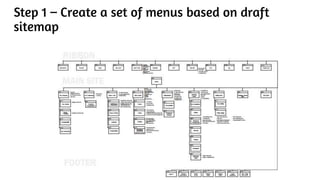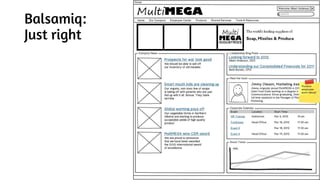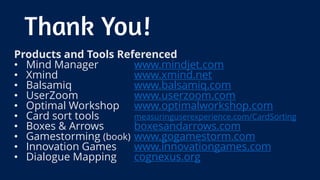Visual tools and innovation games workshop - SPTechCon - Apr 2014
- 1. Visual Tools & Innovation Games Getting everyone onto the same page Ruven Gotz Avanade Michelle Caldwell Avanade
- 2. Low-tech social network Draw your AvatarU Add your name for the Avatar “Tag” your AvatarDraw your Avatar “Upload” your Avatar
- 3. DIRECTOR & REGIONAL LEAD Michelle Caldwell Mary.m.caldwell@avanade.com @shellecaldwell shellecaldwell.com
- 4. DIRECTOR & NATIONAL LEAD Ruven Gotz ruven.gotz@avanade.com @ruveng spinsiders.com/ruveng
- 5. Agenda Part 1 • Introduction • Shared Understanding • Innovation Games & Visual Tools • Soft Skills • Requirements Gathering • Bad Meetings • Envisioning (Cover Story) • Mapping Break Part 2 • Envisioning (IBIS Mapping) • Analyze (Sailboat) • Visual Design • Wireframing • Wrap Up
- 6. Make a Connection & Build a Network
- 7. SHARE 2012 | 7 Shared understanding
- 8. SHARE 2012 | 8
- 9. SHARE 2012 | 9
- 10. SHARE 2012 | 10
- 11. SHARE 2012 | 11
- 12. SHARE 2012 | 12 Yes! A bridge!
- 13. Odds of Success?
- 14. SHARE 2012 | 14 Project goes?
- 15. SHARE 2012 | 15 Same page
- 16. SHARE 2012 | 16 Wicked problems
- 17. SHARE 2012 | 17 Hard (but tame) Wicked
- 19. SHARE 2012 | Usually a bunch of people who all have a different idea of what success looks like
- 20. , won’t talk to each other
- 21. Machiavelli (not exactly ) It must be considered that there is nothing more difficult to carry out nor more doubtful of success nor more dangerous to handle than to initiate a new SharePoint project; for the project team has enemies in all those who profit by the old portal, and only lukewarm defenders in all those who would profit by the new portal; this lukewarmness arising partly from the incredulity of mankind who does not truly believe in anything new until they actually have experience of it.
- 22. Dealing with humans in tough circumstances
- 23. Dealing with humans in tough circumstances
- 24. SHARE 2012 | 24
- 25. How do gamestorming & visual tools help?
- 26. Involves People
- 27. Egalitarian & Participatory • Equal Opportunity to Participate • Success Depends on Everyone get Involved
- 29. 29 Time Bound
- 30. Why they are valuable • They involve a high level of emotion • Alternative to traditional meeting format • Real-time feedback • Helps you discover the unknown • Catalyst for consensus building • Provides structure for Creative Chaos
- 31. Putting it into action Excellent facilitation means building your soft skills
- 32. Soft Skills
- 33. Confidence
- 34. Listening
- 35. Humor
- 36. Brutal Honesty
- 37. Requirements Gathering Visual Tools and Games that can help with analysis
- 38. Why is it so hard to get good requirements?
- 39. The chicken and egg problem
- 40. Requirements
- 41. What makes something a requirement?
- 42. My three rules of SharePoint 1. Simplicity 2. Simplicity 3. Simplicity
- 43. We can do that for $10
- 44. We can do that for $1,000,000
- 45. Too much focus on the detail… How
- 46. …and not enough on the destination Why
- 47. Roadblock: Bad meetings Meetings & workshops take time, but are often ineffective
- 48. The Facts
- 49. 11Million
- 51. 50% Unproductive
- 52. 31 Hours wasted
- 53. The Effects
- 54. 91% Daydreaming
- 57. 73% Bring other work to meetings
- 58. 39% Fall Asleep
- 61. Envisioning Visual Tools and Games that can help with defining Project Goals and Vision
- 63. Soooo…………. What is your vision for SharePoint?
- 64. The object of the game is to suspend all disbelief and envision a future state that is so stellar that it landed your organization on the cover of a well-known magazine.
- 66. Cover: Tells the story of your big success
- 68. Headline: The Substance of the cover story
- 70. Sidebars: Interesting facts about the story
- 72. Quotes: Quotes from potential end users of the solution
- 74. Brainstorm: Documenting initial ideas – this is important!
- 77. Wrap Up At the end of the time period, usually an hour, get the groups to present their cover story, essentially their vision of SharePoint, to the rest of the groups and then discuss.
- 78. Game Setup •Cover Story Template •Post-its •Pens •tape •Facilitator (# depends on size of group •At least 3 participants •A Scribe •Camera (optional)
- 79. Introduction to Mind Mapping
- 94. 1st Half Wrap Up Don’t go away, we’ll be back for Part 2 ruven.gotz@avanade.com spinsiders.com/ruveng @ruveng mary.m.caldwell@Avanade.com shellecaldwell.com @shellecaldwell
- 95. Break
- 96. Welcome to Part 2. IBIS Mapping A Grammar for Thinking
- 97. Two books you must read
- 98. What are wicked problems? (recap) • You don’t really understand the problem until you’ve developed the solution • You don’t know when you’ve accomplished your goal • Solutions are not right or wrong, they are just better or worse • Every wicked problem is unique • Every solution to a wicked problem is a one-shot operation • You are dealing with social complexity
- 99. Tools that can help
- 100. IBIS Notation
- 101. I use Mind Manager to express the same notation
- 106. Dialog mapping to capture argumentation
- 107. Dialog mapping to capture argumentation
- 108. Dialog mapping to capture argumentation
- 109. Dialog mapping to capture argumentation
- 110. Dialog mapping to capture argumentation
- 111. Dialog mapping to capture argumentation
- 114. The object of the game Gain insight and understanding into the current state of the situation
- 115. How to Play the game •Draw and/or put up a boat •Name the boat to represent the focus area
- 118. What can speed you up?
- 120. Power Dot – Extra Bonus •Give each participant a fixed # of dots (time box the activity) •Ask each participant to “vote” for their highest priority pains and solutions •Quickly analyze the results •Discuss the results as a group
- 121. How to Play the game •Analyze voting •Discuss the results as a group
- 122. Game Setup •A BOAT ! •Post-its (various colors) •Pens •tape •Facilitator (# depends on size of group •At least 3 participants •A Scribe •Camera (optional)
- 123. Visual Design Card Sorting & Tree Testing
- 124. What is Card Sorting?
- 125. “Card sorting is a great, reliable, inexpensive method for finding patterns in how users would expect to find content or functionality.” - Donna Spencer http://www.amazon.com/Card-Sorting-ebook/dp/B004VFUOL0
- 126. What are the types of card sort? Open & Closed
- 127. Open card sorting process Gerbil
- 128. Results Gerbil
- 129. But not always what you expect Ford Gerbil
- 130. But not always what you expect (2) Ford Gerbil
- 131. Analysis http://www.boxesandarrows.com/view/analyzing_card_sort_results_ with_a_spreadsheet_template
- 132. What is Tree Testing?
- 133. Formally Known as…….. Card-based Classification Evaluation
- 134. Step 1 – Create a set of menus based on draft sitemap
- 135. Methods for Tree Testing Paper Or Online
- 136. Step 2 – Develop Scenarios
- 137. Creating effective scenarios • You are planning a vacation and you want to know how much leave you have left • You need to book travel for work • You are filling out a request for time off • You are looking for a contact email/name for the helpdesk • You have questions about your benefits
- 138. Step 3 - Recruit
- 139. Step 4 - Observe
- 140. Step 5 - Analyze
- 141. Step 7 - Repeat Create Menu Develop Scenario Recruit Evaluate Analyze Repeat & Optimize
- 142. Wireframing
- 143. I used to hate wireframing!
- 144. A useless wireframe
- 145. Way too much work Erik Swenson
- 146. Balsamiq: Just right
- 147. Simple Wireframe
- 148. Wrap Up
- 149. Adapting the low-tech social network
- 150. Products and Tools Referenced • Mind Manager www.mindjet.com • Xmind www.xmind.net • Balsamiq www.balsamiq.com • UserZoom www.userzoom.com • Optimal Workshop www.optimalworkshop.com • Card sort tools measuringuserexperience.com/CardSorting • Boxes & Arrows boxesandarrows.com • Gamestorming (book) www.gogamestorm.com • Innovation Games www.innovationgames.com • Dialogue Mapping cognexus.org Thank You!
Editor's Notes
- #3: Draw instructions on whiteboard
- #7: Show audience how to make first connectionTime box – 10min max
- #8: One of the key fundamental goals behind everything we are going to see today is to get to shared understanding. That is: get everyone involved to understand what the goals are and what path we’re going to take to get there.These visual and tactile methods have been found to really help you get thereLet me start with an illustration of why shared understanding is so important and how it applies to the type of problems we work with
- #9: Our project is to build a bridge… so here’s a bridge
- #10: But so is this,
- #11: Or this…
- #12: Even this is a bridge
- #13: Our stakeholders are excited about this project!We’ve agreed that we need a bridge!But, if one person pictures a giant steel roadway bridge, others a covered bridge and one simple stepping stones… then…
- #14: Our odds of success are low – in-fact, I’d say zero
- #15: And that means that our project goes down the … um… drain
- #16: So, we need to get everyone onto the same pageWhy is this so important?
- #17: Because SharePoint falls into the category of “Wicked Problems”[I first learned this term from Paul Culmsee of Seven Sigma, Australia’s leading expert in problem wickedness and its solutions]
- #18: A moon-shot is a hard problem, but it can be stated clearly and simply: Take a man to the moon, bring him back aliveCure poverty: That’s a wicked problem. We can’t even agree on who’s poor, what poverty means, and how to know if we’ve been successful.And, when we’re working on TRYING to solve this, solutions are not right or wrong, they are just better or worse.
- #19: SharePoint is wicked with a capital “W”.This is because of the social complexity that SharePoint brings- You want to fundamentally change the way people do their jobs… and that leads to wickedness
- #20: Our stakeholders are excited about this project!We’ve agreed that we need a bridge!But, if one person pictures a suspension bride, others a covered bridge and one simple stepping stones… and…
- #21: Some of whom, won’t talk to each other.OUR CHANCES OF SATISFACTION ARE ZEROThis is social complexity impacting the success of a technology project
- #22: Why is this so hard and dangerousEveryone hates the current portalCan’t find anythingNot sure if content is validBUT- They do know where some stuff is, and this was hard-won knowledge and change to something that won’t be better – just different – is not what they’re looking forward to.
- #23: NEEDS WORKNow, the team working on the new portal has a different state of mind:They are envisioning a fantastic future state and foresee a climb, but the slope isn’t too severe – this is the ‘path of hope’.What they don’t realize is that their immediate rise in Optimistic Excitement is followed by a steep fall into the valley of despair. There are dangerous creatures there – ready to devour your proeject.But, once the reality of the project sets in The valley of despair is a dangerous place, with creatures that have their own agendas ready to ‘eat’ your project
- #24: set up multiple phases toward the eventual future goal, rather than trying to reach that peak inone step, because it is only once you start the journey that you will discover the issues and roadblocksthat are going to make the project much harder than it seemed at the start.Even though it is useful to break the project into phases, it is very important that you do your initialplanning with the ultimate goal in mind so that you don’t paint yourself into a corner by designing a solution thatgets you to the end of phase 1 or 2, but that needs a lot of rework or workarounds to reach the true, final goal.
- #25: To have any chance of success, you MUST have everyone pulling in the same directionThis is a platitude – everyone knows this. The question is “How do we do this!”
- #27: Visualization and Games involve a high level or emotion
- #32: One of the key fundamental goals behind everything we are going to see today is to get to shared understanding. That is: get everyone involved to understand what the goals are and what path we’re going to take to get there.These visual and tactile methods have been found to really help you get thereLet me start with an illustration of why shared understanding is so important and how it applies to the type of problems we work with
- #33: A lot of doing this job well comes down to soft skills: - Listening - Honesty - Humour
- #34: You need to be perceived as the leader of your project, and the team, the stakeholders and the customers must have confidence in you.This does not mean that you have to pretend to know all the answers when you don’t. You can say ‘i’ll get back to you’.But you can’t be uncertain about every question.If you THINK you may be right, answer confidently. When you do a follow-up check – if it turns out that you’re wrong – you can follow up and explain why you changed your answer.You have to come to terms with the fact that, despite all the books and blogs out there, each circumstance is different, and you’ll need to be able choose your own path without a clear map of correct and incorrect.One of my favorite bloggers is Bob Sutton of the Stanford Design School. In one of his posts he writesabout Paul Saffo of the Palo Alto Institute for the Future who taught that leaders must have strong opinions. Weakopinions are uninspiring and don’t motivate people to test them or argue passionately for them. But, it is alsoimportant not to be too strongly wedded to your ideas, because it prevents you from seeing or hearing evidencethat contradicts your opinions. So to be a strong and wise leader you need to have strong opinions, but you need tobe ready to move off those opinions when the evidence requires it. This is summed up in the phrase that youshould take to heart: Strong opinions, weakly held.
- #35: You need to listen to your customers or you will miss important information. If you are conducting aworkshop, you are there to facilitate and gather information, not to impose your vision. You have to bemindful and in the moment. You need to eliminate all possible distractions. This means you turn off orsilence your phone, close your Twitter client (yes, I’ve seen people check their tweets during aworkshop!), and close or silence e-mail (it can really throw a meeting off track when an e-mail “toast”notification pops up on the screen while you’re working).There are a number of books and blogs on how to improve your listening skills. Search the Internetfor “active listening” or “mindful listening.” Choose a book or a program and then practice these skills.It is very important to fully hear what is being said without focusing on what you are going to say inresponse, because once you start to think of your response, you’re not listening anymore and there maybe valuable additional information you are missing.
- #36: Workshops can be stressful for everyone involved. Your customers are taking time out of their busy daysto attend this workshop. They don’t want you to waste their time and, at first, they may not really trustthat you are going to use their time effectively. You are under the gun to deliver a successful workshop,and you need to keep the meeting focused, but you can also keep it a bit light by using humor. This doesnot involve telling jokes, but rather making light of certain situations—especially if you are the target. Ittakes a pretty good level of trust and familiarity before you can make a joke at the expense of one of yourclients, and this is dangerous territory—I have seen it backfire (on me!).Here is an example of light humor in a workshop: We were talking about who would be the editorin-chief of the portal and I nominated someone in the room to be the “Queen of the Portal.” Everyonelaughed (I know, you had to be there), but from then on, she referred to herself (as did the rest of theteam) as the Queen of the Portal, and it served to lighten the mood of the room.
- #37: You need to be brutally honest about yourself. As I said above, if you don’t know something, say so.People can tell when you’re faking—either immediately or later when they find out you didn’t reallyknow. People will rely on your integrity, and once they trust you, they will believe you when you arguethat a particular choice or course is the right oneBeing brutally honest is no excuse for being rude
- #38: Segue: you’ve got the soft skills: Now you need to gather requirements…
- #39: For those of you who have tried gathering requirements in the traditional sense may have heard terms like:“The 3 Magic Questions”“The Perfect Question”“Requirements ESP”“Key Word Analysis”The problem is the true requirements that you need is in one of three categories-I know-I don’t know-I don’t know that I don’t knowWhere do you think most requirements land?
- #40: Analyst: I’m here to help you to implement SharePoint.Customer: Great! What can SharePoint do?Analyst: Lots of things: What do you want it to do?Customer: Um, I’m not sure . . . maybe you can give me a demo.Analyst: Sure: Imagine that you are a bicycle manufacturer in the Pacificnorthwest.Customer: But we aren’t a . . .Analyst: Isn’t this feature cool? It has a bike as a background image.
- #41: So it’s all about the requirements, right?Except it’s not
- #42: Because I said so, and I’m the customer.If you don’t include my requirement, I’ll shootOne of my biggest jobs as a SharePoint BA is to manage this desire. My three rules of SharePoint:
- #43: It’s hard enough to get to success, to get adoption, to build the right thing.Do you know the best way to avoid making a design error in what you build?DON BUILD IT IN THE FIRST PLACE!Start simple – get some success and then grow from there.
- #44: Cheap: Do it!
- #45: Wait a sec – maybe we can think of some alternatives(Hey! Maybe it’s no longer a ‘requirement’)
- #48: So, requirements are tough, but let’s talk about meetings.Most meetings are terrible – they waste time and are very unproductive. Let’s look at some facts…
- #49: Approximately 11 million meetings occur in the US every day
- #50: Approximately 11 million meetings occur in the US every day
- #51: Most professionals attend 61.8 meetings a month
- #52: Of which 50% of them are unproductive
- #53: If each meeting is approx. 1 hour long then professionals lose on average 31 hours per month to ineffective meetings
- #54: If each meeting is approx. 1 hour long then professionals loose on average 31 hours per month to ineffective meetings
- #59: If each meeting is approx. 1 hour long then professionals loose on average 31 hours per month to ineffective meetings
- #60: How are most requirements gathered?[THIS SLIDE IS NOW ANIMATED – watch it in presentation mode]In meetings right? Let’s look at how productive the average meetings is
- #62: So, if requirements are hard, and regular meetings to nail them down are terrible, what can we do?We’re going to go through our first Innovation Game. This time, we’ll walk through how it works without playing it, but soon we’ll actually play one of the games.
- #65: Cover Story is a game about pure imagination. The purpose is to think expansively around an ideal future state for the organization; it’s an exercise in visioning. The object of the game is to suspend all disbelief and envision a future state that is so stellar that it landed your organization on the cover of a well-known magazine.
- #66: Cover: Tells the story of their big successHeadline: The substance of the cover storySidebars: Interesting facts about the storyQuotes: Quotes from potential end users of the solutionBrainstorm: documenting initial ideas (this is important!)Images: Supporting the content with illustrationsThe players must pretend as though this future has already taken place and has been reported by the mainstream media. This game is worth playing because it not only encourages people to “think big,” but also actually plants the seeds for a future that perhaps wasn’t possible before the game was playedThe reason that this works particularly well for SharePoint is that there are a number of possible visions that an organization may have for the platform. The Cover Story game gives you enough structure to ensure that you get tangible examples without constraining users from being able to really explore the many possible end states.At the end of the time period, usually an hour, get the groups to present their cover story, essentially their vision of SharePoint, to the rest of the groups and then discuss.
- #67: Cover: Tells the story of their big successCover Story is a game about pure imagination. The purpose is to think expansively around an ideal future state for the organization; it’s an exercise in visioning. The object of the game is to suspend all disbelief and envision a future state that is so stellar that it landed your organization on the cover of a well-known magazine. The players must pretend as though this future has already taken place and has been reported by the mainstream media. This game is worth playing because it not only encourages people to “think big,” but also actually plants the seeds for a future that perhaps wasn’t possible before the game was playedThe reason that this works particularly well for SharePoint is that there are a number of possible visions that an organization may have for the platform. The Cover Story game gives you enough structure to ensure that you get tangible examples without constraining users from being able to really explore the many possible end states.At the end of the time period, usually an hour, get the groups to present their cover story, essentially their vision of SharePoint, to the rest of the groups and then discuss.
- #69: Cover: Tells the story of their big successHeadline: The substance of the cover storySidebars: Interesting facts about the storyQuotes: Quotes from potential end users of the solutionBrainstorm: documenting initial ideas (this is important!)Images: Supporting the content with illustrationsCover Story is a game about pure imagination. The purpose is to think expansively around an ideal future state for the organization; it’s an exercise in visioning. The object of the game is to suspend all disbelief and envision a future state that is so stellar that it landed your organization on the cover of a well-known magazine. The players must pretend as though this future has already taken place and has been reported by the mainstream media. This game is worth playing because it not only encourages people to “think big,” but also actually plants the seeds for a future that perhaps wasn’t possible before the game was playedThe reason that this works particularly well for SharePoint is that there are a number of possible visions that an organization may have for the platform. The Cover Story game gives you enough structure to ensure that you get tangible examples without constraining users from being able to really explore the many possible end states.At the end of the time period, usually an hour, get the groups to present their cover story, essentially their vision of SharePoint, to the rest of the groups and then discuss.
- #71: Cover: Tells the story of their big successHeadline: The substance of the cover storySidebars: Interesting facts about the storyQuotes: Quotes from potential end users of the solutionBrainstorm: documenting initial ideas (this is important!)Images: Supporting the content with illustrationsCover Story is a game about pure imagination. The purpose is to think expansively around an ideal future state for the organization; it’s an exercise in visioning. The object of the game is to suspend all disbelief and envision a future state that is so stellar that it landed your organization on the cover of a well-known magazine. The players must pretend as though this future has already taken place and has been reported by the mainstream media. This game is worth playing because it not only encourages people to “think big,” but also actually plants the seeds for a future that perhaps wasn’t possible before the game was playedThe reason that this works particularly well for SharePoint is that there are a number of possible visions that an organization may have for the platform. The Cover Story game gives you enough structure to ensure that you get tangible examples without constraining users from being able to really explore the many possible end states.At the end of the time period, usually an hour, get the groups to present their cover story, essentially their vision of SharePoint, to the rest of the groups and then discuss.
- #73: Cover: Tells the story of their big successHeadline: The substance of the cover storySidebars: Interesting facts about the storyQuotes: Quotes from potential end users of the solutionBrainstorm: documenting initial ideas (this is important!)Images: Supporting the content with illustrationsCover Story is a game about pure imagination. The purpose is to think expansively around an ideal future state for the organization; it’s an exercise in visioning. The object of the game is to suspend all disbelief and envision a future state that is so stellar that it landed your organization on the cover of a well-known magazine. The players must pretend as though this future has already taken place and has been reported by the mainstream media. This game is worth playing because it not only encourages people to “think big,” but also actually plants the seeds for a future that perhaps wasn’t possible before the game was playedThe reason that this works particularly well for SharePoint is that there are a number of possible visions that an organization may have for the platform. The Cover Story game gives you enough structure to ensure that you get tangible examples without constraining users from being able to really explore the many possible end states.At the end of the time period, usually an hour, get the groups to present their cover story, essentially their vision of SharePoint, to the rest of the groups and then discuss.
- #75: Cover: Tells the story of their big successHeadline: The substance of the cover storySidebars: Interesting facts about the storyQuotes: Quotes from potential end users of the solutionBrainstorm: documenting initial ideas (this is important!)Images: Supporting the content with illustrationsCover Story is a game about pure imagination. The purpose is to think expansively around an ideal future state for the organization; it’s an exercise in visioning. The object of the game is to suspend all disbelief and envision a future state that is so stellar that it landed your organization on the cover of a well-known magazine. The players must pretend as though this future has already taken place and has been reported by the mainstream media. This game is worth playing because it not only encourages people to “think big,” but also actually plants the seeds for a future that perhaps wasn’t possible before the game was playedThe reason that this works particularly well for SharePoint is that there are a number of possible visions that an organization may have for the platform. The Cover Story game gives you enough structure to ensure that you get tangible examples without constraining users from being able to really explore the many possible end states.At the end of the time period, usually an hour, get the groups to present their cover story, essentially their vision of SharePoint, to the rest of the groups and then discuss.
- #77: Cover: Tells the story of their big successHeadline: The substance of the cover storySidebars: Interesting facts about the storyQuotes: Quotes from potential end users of the solutionBrainstorm: documenting initial ideas (this is important!)Images: Supporting the content with illustrationsCover Story is a game about pure imagination. The purpose is to think expansively around an ideal future state for the organization; it’s an exercise in visioning. The object of the game is to suspend all disbelief and envision a future state that is so stellar that it landed your organization on the cover of a well-known magazine. The players must pretend as though this future has already taken place and has been reported by the mainstream media. This game is worth playing because it not only encourages people to “think big,” but also actually plants the seeds for a future that perhaps wasn’t possible before the game was playedThe reason that this works particularly well for SharePoint is that there are a number of possible visions that an organization may have for the platform. The Cover Story game gives you enough structure to ensure that you get tangible examples without constraining users from being able to really explore the many possible end states.At the end of the time period, usually an hour, get the groups to present their cover story, essentially their vision of SharePoint, to the rest of the groups and then discuss.
- #81: We’ve looked how gamestorming can help, let’s dig in to another type of visual tool
- #82: Mind mapping is not newBeen around a long time, and used for brainstorming
- #89: XMind is a shareware system that does a lot of what Mind Manager does.
- #100: This is a recap
- #102: Four symbols, very simple(tricky to master)
- #115: How can we look at requirements from a different perspective?We’ve seen how the Cover Story game can surface the goals that the business often has trouble articulating.Now, we’re going to use a game to surface the underlying drivers and potential roadblocks to success.
- #116: The game Speedboat is a quick and painless way to gain insight and understanding into the current state of the situation –
- #117: The principle of the game is to draw a boat with couple of anchors and engines. (in this example we simply used post-its) The boat should be named to represent a focus area (especially if you are going to examine large group of problems).After that you can apply grouping, sorting and/or voting the same way as you know in retrospective in agile/scrum.Result: a lot of ideas get presented without any hassles and participants freely promote possible/expected solutions that can be immediately changed into action items Speed Boat game allows not just open minds, but efficiently provides a strategy how to solve your problems. Additionally, trust and expectations are more clear.
- #118: Ask team members to write what is slowing down the boat (one idea per card/post-it) and to pin the card to anchor or below water level
- #119: After that you can apply grouping, sorting and/or voting the same way as you know in retrospective in agile/scrum.Result: a lot of ideas get presented without any hassles and participants freely promote possible/expected solutions that can be immediately changed into action items Speed Boat game allows not just open minds, but efficiently provides a strategy how to solve your problems. Additionally, trust and expectations are more clear.
- #120: Let team members to write ideas what can speed up the boat and pin cards to an engine (if you have a speedboat) or above the boat (if you have a sailboat) to represent “wind in the sails”.
- #121: After that you can apply grouping, sorting and/or voting the same way as you know in retrospective in agile/scrum.Result: a lot of ideas get presented without any hassles and participants freely promote possible/expected solutions that can be immediately changed into action items Speed Boat game allows not just open minds, but efficiently provides a strategy how to solve your problems. Additionally, trust and expectations are more clear.
- #123: The principle of the game is to draw a boat with couple of anchors and engines. (in this example we simply used post-its) The boat should be named to represent a focus area (especially if you are going to examine large group of problems).After that you can apply grouping, sorting and/or voting the same way as you know in retrospective in agile/scrum.Result: a lot of ideas get presented without any hassles and participants freely promote possible/expected solutions that can be immediately changed into action items Speed Boat game allows not just open minds, but efficiently provides a strategy how to solve your problems. Additionally, trust and expectations are more clear.
- #125: Other tools/techniques that use visual/tactile approach
- #126: A technique to get input orfeedback from usersYou may have great ideas of how to organize you intranet, but you users may have different ideas
- #127: To continue to quote Donna:Card sorting is best understood not as a collaborative method for creating navigation,but rather as a tool that helps us understand the people we are designing for.
- #128: In an open sort, people are not given any categories, they just have to organize concepts into groups.In a closed sort, people are told the headings and then they have to sort concepts under the categories that they’ve been given
- #129: The analysis can be useful, but it is the process of watching people do the sorts that helps provide the real value
- #130: It’s a method to test how well your site structure guides site-users to the content they are looking forThis is a simple and cost effective method for assessing the proposed site architecture, prior to wire framing avoiding difficult and expensive rework.
- #132: Create a set of menus (paper or online) based on your draft site structure
- #134: Develop a set of scenarios or tasks that represent how staff will use the site.
- #136: Recruit a range of site-users that represent the target audience for the site/solution
- #137: Observe staff members actions as they “look” for the information listed in each scenario
- #138: Analyze the successes and failures of the site structure and refine what you have and retestRemember the staff themselves never fail
- #139: Rinse and Repeat until desired result is achieved
- #149: This tool called ‘Balsamiq’ makes it extremely simple and fast to make wireframes.They look cartoonish, but that makes it easy to focus on what’s important (not color, font, etc.)


